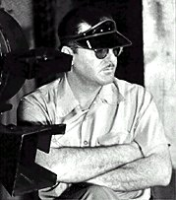
When watching Citizen Kane, I’ve always felt that Gregg Toland’s input was always understated in history book. Yet, through recent years Toland has been receiving more and more credit for his cinematography on Citizen Kane. One only needs to watch his earlier cinema graphic efforts (like Dead End. Wuthering Heights and Grapes of Wrath) to see that the look of Citizen Kane is more Toland than Welles. Carringer’s article does a good job bringing to light Toland’s efforts. Though through the article I also realized that maybe Welles had more input than I’d previously thought. With such ground breaking techniques as deep-focus, log takes, low-angle and a variety of compositional camera angles, Citizen Kane revolutionized movie making as a true art form.
Tolland was not just a cinematographer but a technical innovator as well. Carringer refers to Toland as a “gadgeteer” who could make any gadgets work for him. Many processes and devices that are in use to this day were invented by Toland. Toland made good use of BNC camera, which allowed him to film action in close proximity. Despite typical halo effects derived from shooting directly into light, Toland was able to eliminate this effect by removing the sliding aperture from the lens and added an insert that was normally be used for still photography. This was called a “waterhouse stop.” During Citizen Kane, Welles would often encourage Toland’s tinkering.
Despite all that Toland brought to the filming of Citizen Kane, it was through Welles’ encouragement that Toland was able to master many of his experiments. Where in earlier film like The Long Voyage Home, some of Toland’s work is at odds with the directors intentions; Citizen Kane works a harmonious integration between director and cinematographer. A new sense of reality is born in the film, mixing Toland’s reality with that of Welles’ showmanship.
Though Toland’s work is remarkable in Citizen Kane and he was nominated as best cinematographer by the Academy, he lost out to Arthur Miller for How Green Was My Valley. It is through this decision that makes obvious the resentment that the Academy felt about Citizen Kane, which is possibly due to Hearst, who had been trying to put a stop to the film upon its release. Apparently, Hearst was upset at the way his wife was portrayed in the film (see documentary on Hearst Vs. Kane). Though after so many years, Citizen Kane is finally recognized as one of the crowning achievements in film history.

No comments:
Post a Comment